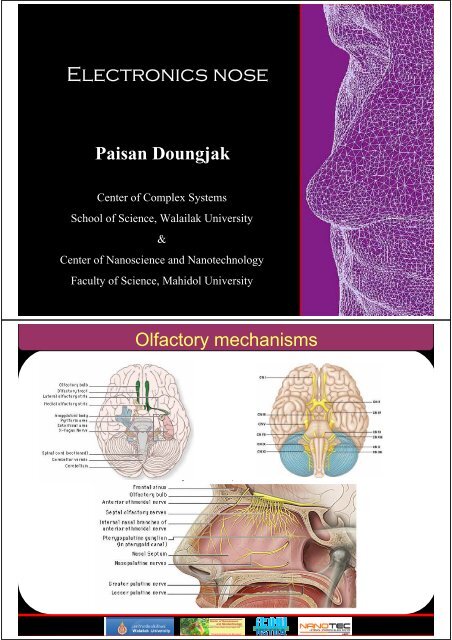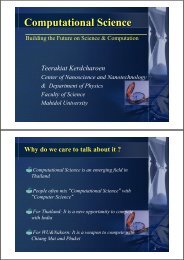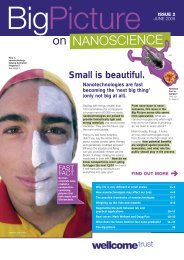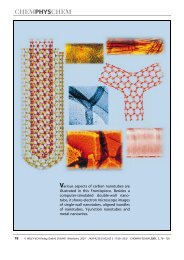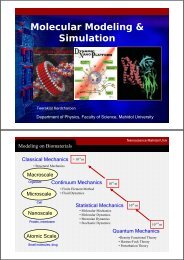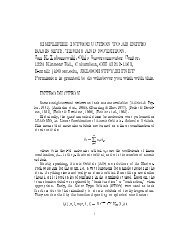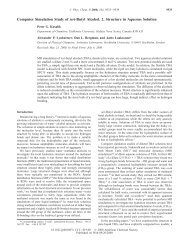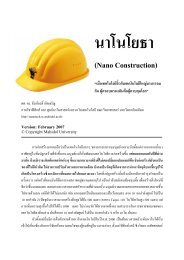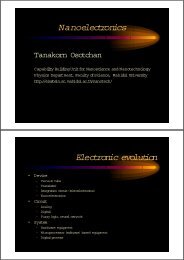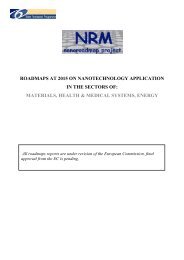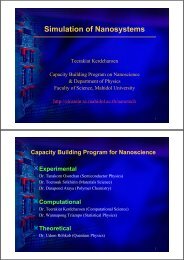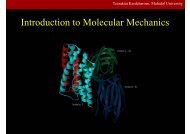Electronics nose - Nano Mahidol - Mahidol University
Electronics nose - Nano Mahidol - Mahidol University
Electronics nose - Nano Mahidol - Mahidol University
Create successful ePaper yourself
Turn your PDF publications into a flip-book with our unique Google optimized e-Paper software.
<strong>Electronics</strong> <strong>nose</strong><br />
Paisan Doungjak<br />
Center of Complex Systems<br />
School of Science, Walailak <strong>University</strong><br />
&<br />
Center of <strong>Nano</strong>science and <strong>Nano</strong>technology<br />
Faculty of Science, <strong>Mahidol</strong> <strong>University</strong><br />
Olfactory mechanisms
What is the electronic <strong>nose</strong><br />
Human mimic <strong>nose</strong><br />
Olfactory<br />
epitheium<br />
Proceedings of 2004 IEEE/RSJ international conference<br />
ELECTRONIC NOSE<br />
Conventional Olfactory laboratory<br />
relies on human <strong>nose</strong><br />
But human <strong>nose</strong> get tired with more<br />
samples….
ELECTRONIC NOSE<br />
How electronic <strong>nose</strong> works:<br />
Scheme of the human olfactory system.<br />
Schematics of an electronic <strong>nose</strong>.<br />
Electronic <strong>nose</strong> system :<br />
ELECTRONIC NOSE<br />
• Types of transducer sensor<br />
- Quartz crystal Micro Balances (QMB)<br />
- Surface Acoustic Wave Sensors (SAW)<br />
- Metal Oxide Semiconductor Sensors<br />
(MOS)**<br />
- Metal Oxide Field Effect Transistors<br />
(MOSFET)<br />
- Conducting Organic Polymers (COP)
Optical sensor<br />
Gravimetric Odor Sensors<br />
Quartz crystal<br />
microbalance, QCM<br />
Surface acoustic<br />
wave, SAW<br />
Principal of QCM click!<br />
booming cellular telephones<br />
market<br />
Base on piezoelectric substrate;quart,LiNbO 3 and ZnO
Chemoresistive sensors<br />
Metal Oxide Semiconductors (MOS)<br />
SnO 2<br />
O<br />
O<br />
grains<br />
2<br />
2<br />
O -<br />
O - O -<br />
2 O - 2 O - 2<br />
O - 2<br />
2 e - e - e<br />
2 e e - e-<br />
O - 2 O - e - ē -<br />
2<br />
O ē - 2 e - e -<br />
e -<br />
Space charge<br />
region<br />
O - 2<br />
eē- O - 2<br />
O - 2<br />
O 2<br />
e -<br />
e -<br />
e - O - 2<br />
O - 2<br />
O 2<br />
+ e - O - 2<br />
½O 2<br />
+ e - O -<br />
½O 2<br />
+ 2e - O 2-<br />
φ b<br />
chemical equaltion :<br />
1<br />
−<br />
e+ O2<br />
⎯⎯→ O()<br />
s<br />
2<br />
−<br />
Rg ( ) + Os ( ) ⎯⎯→ ROg ( ) + e<br />
O 2<br />
CO O 2<br />
CO<br />
eē- e - e -<br />
O - e -<br />
e - e - 2<br />
e - e<br />
e e - e-<br />
e - e-e- O e - e - e - e - e - e - e -<br />
2<br />
e - e -<br />
O 2<br />
O - 2 + CO CO 2 + e-<br />
CO<br />
O - + CO CO 2<br />
+ e -<br />
O 2- + CO CO 2<br />
+ 2e -<br />
φ b<br />
Pattern Classify<br />
Data analysis : Pattern Classification<br />
• Statistical method<br />
- Principal component analysis (PCA)<br />
- Partial least-square (PLS)<br />
- Principal component regression (PCR)<br />
- Cluster analysis (CA) and etc.<br />
• Biological non-parametric<br />
methodologies artificial neural<br />
network, ANNS)<br />
- Multi-layer perception (MLP)<br />
- Self-organizing map (SOM)<br />
- Neural fuzzy system (NFS) and etc.
ELECTRONIC NOSE<br />
Model base<br />
Qualitative<br />
Quantitative<br />
Model free<br />
Classification scheme of the multivariate<br />
pattern analysis techniques in ENs<br />
ELECTRONIC NOSE<br />
PRINCIPAL COMPONENT ANALYSIS<br />
Aim: lower dimensional representation<br />
and visualization of the data in terms<br />
of scores on (uncorrelated) principal<br />
component > score plot<br />
Measurement on p (correlated)<br />
variances on n objects/ individuals/<br />
experimental units<br />
Choice to be made:<br />
-covariance or correlation matrix (raw<br />
or standardized data)<br />
-the number of PC’s to be used
ELECTRONIC NOSE<br />
Data acquisitions:<br />
Data transfer can be used<br />
-Serial port<br />
-Parallel port<br />
-Infrared transfer (iR)<br />
-Bluetooth<br />
-Wi-Fi<br />
And to be collected by PC<br />
Experimental setup<br />
ELECTRONIC NOSE<br />
– MATLAB TM TGS2602 VOCs and odorous gases<br />
To electronics<br />
• Four commercial MOS sensors (Now)<br />
– Figaro : AF63, TGS822, TGS2600, TGS2602<br />
sensor<br />
• Static chamber + headspace analysis<br />
– Concentration of coffee = 0.12g/litre<br />
– 10 ml analytic odor in 125ml flask<br />
analyte<br />
– Sensor inserted through a tight aperture on the cap<br />
– This setup eliminates cooling effects by effluent flow<br />
• Analytic database<br />
– Operation time used in 30 min.<br />
Model Description (by manufactory)<br />
• Interface requirements<br />
AF 63 alcohol and gas leak<br />
– LabVIEW TM<br />
TGS 822 organic solvent vapors<br />
– RS-232 port<br />
TGS2600 Low concentrations of air<br />
• Analysis programming<br />
contaminates
ELECTRONIC NOSE<br />
- the transducer to be used in EN<br />
Odor samples:<br />
ELECTRONIC NOSE<br />
#<br />
1<br />
2<br />
3<br />
4<br />
5<br />
6<br />
7<br />
8<br />
Type<br />
Moccona-select<br />
Moccona-royal gold<br />
Nescafe-Redcup<br />
Nescafe-Gold<br />
Khao shong-brown<br />
Khao shong-red<br />
OEM-Big C<br />
Superclass
ELECTRONIC NOSE<br />
Results : the experiment data of Thai-coffees were collected<br />
ELECTRONIC NOSE<br />
Feature extraction – have many methods<br />
- Maximum value was used to statistical recognition.<br />
- signal preconditioning : wavelet transform (to be next time)<br />
Maximum value
ELECTRONIC NOSE<br />
Model base<br />
Qualitative<br />
Quantitative<br />
Model free<br />
Classification scheme of the multivariate<br />
pattern analysis techniques in ENs<br />
ELECTRONIC NOSE<br />
Results : The principal component<br />
analysis of Thai-coffees brand in<br />
10, 25 and 40 degree Celsius<br />
10 degree Celsius<br />
25 degree Celsius<br />
40 degree Celsius
ELECTRONIC NOSE<br />
For application works<br />
-To use analyses of freshness of product<br />
e.g. Beverage, food product<br />
-Environment monitoring :<br />
e.g Aqueous sensor Network<br />
-Movable robot,<br />
Bomb detector,<br />
rescue robot ,etc…


